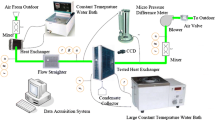Abstract
The heat transfer characteristics of refrigerant-oil mixture for horizontal in-tube evaporator have been investigated experimentally. A smooth copper tube and a micro-fin tube with nominal 9.5 mm outer diameter and 1500 mm length were tested. For the pure refrigerant flow, the dependence of the axial heat transfer coefficient on quality was weak in the smooth tube, but in the micro-fin tube, the coefficients were 3 to 10 times greater as quality increases. Oil addition to pure refrigerant in the smooth tube altered the flow pattern dramatically at low mass fluxes, with a resultant enhancement of the wetting area by vigorous foaming. The heat transfer coefficients of the mixture for low and medium qualities were increased at low mass fluxes. In the micro-fin tube, however, the addition of oil deteriorates the local heat transfer performance for most of the quality range, except for low quality. The micro-fin tube consequently loses its advantage of high heat transfer performance for an oil fraction of 5%. Results are presented as plots of local heat transfer coefficient versus quality.
Similar content being viewed by others
Abbreviations
- De :
-
Envelope diameter (mm)
- Do :
-
Outside diameter
- f:
-
Fin height (mm)
- G:
-
Mass flux (kg/(m2s))
- q:
-
Heat flux (kW/m2)
- t:
-
Tube thickness
References
ASHRAE Standard, 1984, “Standards Method for Measurement of Proportion of Oil in Liquid Refrigerant” ASHRAE 41. 4
Eckels, S. J. and Pate, M. B. 1991, “Evaporation and Condensation of HFC-134a and CFC-12 in a Smooth Tube and a Micro-fin Tube,”ASHRAE Trans., Vol. 97, pt. 2, pp. 71–81.
Ha, S. 1992, “Heat Transfer Characteristics of Horizontal In-Tube Evaporation,” Ph. D. Thesis, Rensselaer Polytechnics Institute, Troy, NY.
Ha, S. and Bergles, A. E. 1993a, “The Influence of Oil on Local Evaporation Heat Transfer Inside a Horizontal Micro-fin Tube,”ASHRAE Trans., Vol. 99, pt. 1, pp. 1244–1255.
Ha, S. and Bergles, A. E. 1993b “Local Heat Transfer Characteristics of Horizontal In-Tube Evaporation,”Proc. 6th Int. Symp. Transport Phenomena, Seoul, Korea, Vol. 2, pp. 357–364.
Ito, M., Kimura, H. and Senshu, T. 1977, “Development of High Efficiency Air-cooled Heat Exchanger,”Hitachi Review, Vol. 26, No. 10, pp. 323–326.
Kandlikar, S. G. 1990, “A General Correlation for Saturated Two-Phase Flow Boiling Heat Transfer Inside Horizontal and Vertical Tubes,”J. Heat Transfer, Vol. 112, No. 1, pp. 219–228.
Kim, J-D., Yoon, J-I., Ku, H-G., 1997, “Dynamic Analysis of Evaporator Characteristics,”KSME Int. J., Vol. 11, No. 2, pp. 221–228.
Kim, J. S., Nagata, K., Katsuta, M., Tomosugi, H., Kikuchi, K., & Horichi, T., 1988, “Influence of Oil on Refrigerant Evaporator Performance-1st Report: Local Heat Transfer Coefficients,”Trans. JAR, Vol. 5, No. 1, pp. 89–96.
Kimura, H. and Ito, M. 1981, “Evaporating Heat Transfer in Horizontal Internal Spiral-Grooved Tubes in the Region of Low Flow Rates,”JSME Int. J., Vol. 24, No. 195, pp. 1602–1607.
Manwell, S. P. and Bergles, A. E. 1990, “Gas-Liquid Flow Pattern in Refrigerant-Oil Mixtures,”ASHRAE Trans., Vol. 96, pt. 2, pp. 456–464.
Schlager, L. M., Bergles, A. E. and Pate, M. B. 1988, “Evaporation and Condensation of Refrigerant-Oil Mixtures in a Smooth Tube and a Micro-fin Tube,”ASHRAE Trans., Vol. 94, pt. 1, pp. 149–166.
Schlager, L. M., Bergles, A. E., and Pate, M. B. 1989, “A Comparison of 150 and 300 SUS Oil Effects on Refrigerant Evaporation and Condensation in a Smooth Tube and a Micro-fin Tube,”ASHRAE Trans., Vol. 95, pt. 1, pp. 387–397.
Tatsumi, A, Oizumi, K., Hayashi, M., and Ito, M., 1982, “Application of Inner Groove Tubes to Air Conditioners,”Hitachi Cable Review, Vol. 32, No. 1, pp. 55–60.
Torikoshi, K., Kawabata, K., and Ebisu, T., 1992, “Heat Transfer and Pressure Drop Characteristics of HFC-134a in a Horizontal Heat Transfer Tube,”Proc. Int. Refrigeration Conf., Purdue, July, Vol. 1, pp. 167–176.
Torikoshi, K. and Ebisu, T. 1993, “Heat Transfer and Pressure Drop Characteristics of R-134a, R-32, and a Mixture of R-32/R-134a inside a Horizontal Tube,”ASHRAE Trans., Vol. 99, pp. 350–356.
Yoshida, S., Matsunaga, T., Hong, H-P., and Nishikawa, K. 1988, “Heat Transfer Enhancement in Horizontal, Spirally Grooved Evaporator Tubes,”JSME Int. J., Vol. 31, No. 3, pp. 505–512.
Author information
Authors and Affiliations
Corresponding author
Rights and permissions
About this article
Cite this article
Ha, S. Some aspects of experimental in-tube evaporation. KSME International Journal 14, 537–546 (2000). https://doi.org/10.1007/BF03185656
Received:
Revised:
Issue Date:
DOI: https://doi.org/10.1007/BF03185656




